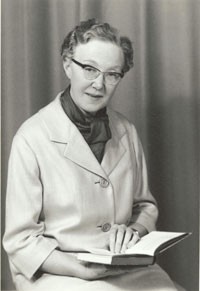Borghild Krane
Borghild Krane (1906 – 1997) grew up in Tromsø in Northern Norway. She was a doctor, a psychiatrist and a librarian, and also an active Catholic and author of several books on the Norwegian naturalist writer Amalie Skram. In addition to this, Krane wrote fictional texts, among these probably the first novel in Norwegian literature history openly describing lesbian love: Følelsers forvirring (The Disarray of Emotions) from 1937, published by Gyldendal publishing house. The title is taken from a short story by Stefan Zweig - Verwirrung der Gefuhle – that was published ten years earlier, describing the same topic. In Krane’s novel, the main character Åse says:
Even if one suddenly finds oneself in an isolated ocean of loneliness and desolation, it is actually not the world going under or existence losing its meaning – it is only the confusion of emotions.
Følelsers forvirring is a bildungsroman. The main character, Åse, grows up in Tromsø, is a student in Oslo and Cambridge, and later works as a teacher in Norway. She soon realises that she is a lesbian, and tries to protect herself against it – but that seems to be impossible. “She only saw the women. […] Only the women had life.” Actually, it should all be quite simple. “It was just to say: I am like that”. But she could not do it. To accept something like that would create new, insolvable problems. But she was not able to ignore those feelings, either.
“Why not lead on for what your inner voice screams for?” Åse asks herself. Is it because one is weak, and incompetent, or is it because one does not want to make social disorder? When you know that you are standing in the face of a hostile superior power, “should you, then, realise your colours and be broken, or should you stay silent, and live”? Åse chooses the last, while her friend Randi has more of a courage to be herself – at least when abroad. Randi wants to be accepted as she is. “Is there anyone who thinks that we are what we are for fun?” Neither can she take into regard if “nature” in itself is against it – “after all, this is our nature and we want the right to live it”. A society needs to have its rules, Åse says, but Randi does not agree.
Well, but why should we merely be mentioned in the Criminal Code? Why can we not claim any form for social protection? Why should we not be able to marry and make homes together?
Åse is the more conservative, she wants to follow the rules of the society. She does not want to create more of a chaos than what already is. “Chaos? There will be chaos as long as there is no justice”, Randi answers, and she kicks the table and expresses what seems to be a key strategy for all struggles against oppression and discrimination: “We should organise […]. There are many enough of us”.
Randi does also philosophise on what happens to us as human beings when we realise that our way of loving is defined by society as unnatural and reprehensible. The relationships to our fellow human beings are decided by the amount of sympathy and understanding of the others. Filled with pity and with guilt, the homosexuals are longing for sympathy: “We crave sympathy. The one giving me sympathy is noble and good, and the one denying me of it - narrow-minded and fierce. Anywhere sympathy is thrown upon us, we cling.” Randi puts an irony to her words, but there is also an undertone of seriousness. The best solution is probably to live in celibacy; to “forsake, work, and die on duty”. Her emotions has left her bewildered. She feels her homosexual tendency to be both a hallmark, and a stigma.
The story’s plot takes a turn towards the end of the book, when the writer introduces a male character, a russian (gay?) refugee named Dmitri. An awkward and probably unlikely threesome constellation appears. The story has no happy ending, something that would hardly be possible in the 1930s. Randi is hit by a car and killed, Dmitri takes his leave, and Åse is left alone, again. From now on, she will avoid any emotional closeness to others, to “avoid getting overwhelmed by the well-known, uncomfortable feeling of misery, worthlessness and guilt. This strange, mysterious guilt – so undeserved.”
The reviews for Følelsers forvirring were mainly negative, not least because of its topic, but in later years, the discussion of the book have become more of a “wise after the fact”. At the time, some critics felt sorry for the two “half-gendered” persons; defect and unnatural women. Hans Lyche, writing for Norges Handels- og Sjøfartstidende (The Norwegian Commerce and Shipping News), was one of few critics acclaiming the book and the strenuous struggle for happiness it depicts.
Borghild Krane’s 1937 novel is, without doubt, a pioneering work within the queer field, both as literature and as information. In the book, love between women seems to be an unachievable goal. It is a love that cannot be repressed, but neither be lived. The society does not accept it. That is the painful truth. But the characters are fully aware of their emotions, however confused they may feel.
The author even presents a new and original definition of homosexuals: A race that does not reproduce, but still does not perish.
*Translated from Norwegian by Heidi Rohde Rafto
Bibliography
Krane, Borghild. 1937. Følelsers forvirring. Oslo: Gyldendal.
Utnes, Astrid. 1993. Følelser i eksil. Lesbisk identitet i norsk mellomkrigslitteratur med analyse av Borghild Kranes roman Følelsers forvirring. Tromsø: Universitetet.
Waage, Lars. 2012. "Borghild Kranes Følelsers forvirring (1937) – en queer lesning av Norges første lesbiske roman". Norsk litteraturvitenskapelig tidsskrift 1:16-27.

